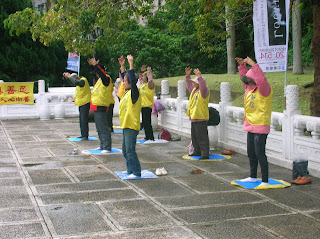After checking out of the Star Hostel, I walked back to the Taipei Main Station and bought an unlimited 2-day subway travel card. I then hopped on the subway headed to the National Palace Museum (NPM), probably Taiwan's top tourist sight. I thought the NPM was walking distance from the subway stop and started walking towards the museum. However, after walking a few blocks with the NPM nowhere in sight, I decided to ask a young couple how to get there. They informed me I needed to take a bus. I was debating this and decided that I would just walk back to the subway and go somewhere else. However, upon walking back, I saw a bus with the museum’s name on it via it’s scroll on the outside and decided to hop on. About 10 minutes later, I arrived at the NPM in the Shilin district of Taipei. Admission was 160 TWD (~ $5).
The NPM houses the world’s largest and best collection of Chinese art treasures, historical artifacts, and antiquities; one which spans China’s nearly 5,000-year history.
The NPM was originally founded in 1925 in the Forbidden City in Beijing, which explains why the word ‘Palace’ is used in its name. Beginning in 1931, the collection was moved into the hinterland of China to avoid the ravages of the impending Sino-Japanese War. In 1949, with civil war raging between the nationalist government and the Communists, the Republic of China shipped about 600,000 of some of the most precious objects in the collection to Taiwan. Needless to say, the Communists weren't very happy about this, but this way the treasures were probably saved from destruction in the Cultural Revolution. Not until 1965 were they moved to their present home in Taipei.
The collection is now 680,000 strong making it the premier holding of Chinese art & culture in the world. There was so much to see and not enough time. I wanted to see so many things in Taipei and only had two full days to accomplish my goals. You could have spend a full day here and I spent about two hours. There are four floors with a huge gift shop in the basement. There was also a cafe, restaurant, and tea-house. Some of the exhibits: Republic of China's Diplomatic Archives; Fine Painting and Calligraphy; Compassion and Wisdom – Religious Sculptural Arts; Art in Quest of Heaven and Truth – Chinese Jades through the Ages; Rituals Cast in Brilliance – Chinese Bronzes through the Ages; Uncanny Ingenuity and Celestial Feats – The Carvings of Ming (1368-1644 C.E.) and Qing (1644-1911 C.E.) Dynasties; The Magic of Kneaded Clay – A History of Chinese Ceramics; Arts from the Ch'ing Imperial Collection; Splendors of Ch'ing Furniture; Nature and Human Unison – Beautiful Stones; The Bell and Cauldron Inscriptions – a Feast of Chinese Characters – the Origin and Development; Rare Books and Documents Galleries; and Arts from the Qing Imperial Collection.
As you can see below, the NPM sits at the footsteps of a small mountain. People were practicing Tai Chi. The complex encompasses a couple exhibition halls, administrative buildings, gardens, and a restaurant.










knew from the posture that was tai chi. how cool. so glad things were saved. china has such a rich history. can you imagine if all was lost. i am sorry you did not have more time. would have loved to see the gift shop. wow. i am so constantly impressed. everything is so nice and neat and green. wow...........
ReplyDeleteThis is Duke. As always, very interesting. Looks like a good crowd there on the day of your visit. The exhibit on calligraphy would have interested me as I believe that calligraphy originated in China, although I have a hard time visualizing what Chinese characters would look like in calligraphy, as the letters are difficult enough anyway.
ReplyDeleteVery nice. Love how lush and green everything looks. Like those two sculptures up on the white blocks.
ReplyDelete